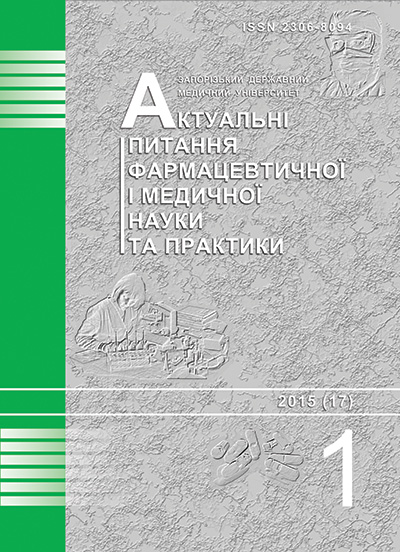THE DEVELOPMENT OF METHOD FOR MINT AND TURMERIC ESSENTIAL OILS IDENTIFICATION AND QUANTITATIVE ANALYSIS IN COMPLEX DRUG
DOI:
https://doi.org/10.14739/2409-2932.2015.1.41343Keywords:
Drug Combination, Volatile Oils, Gas Chromatography, AnalysisAbstract
Introduction.The aim of our study was to develop the method for identification and assay of essential oils of mint and turmeric in complex medicinal product in capsule form.
Materials and method.The paper used samples of turmeric and mint essential oils and complex drug, in the form of capsules containing oil of peppermint, oil of Curcuma longa, a mixture of extracts sandy everlasting (Helichrysumarenarium (L.) Moench), marigold (Caléndulaofficinális L), wild carrot (Daucussarota) and Curcuma longa (Curcuma longa).
Results and discussion. The structure of the complex drug is dry extract sand everlasting flowers, wild carrot extract of marigold flowers and fruits thick, dry extract of Curcuma longa and essential oils of peppermint and turmeric.
According to the research of different samples of peppermint oil, and given the need for its identification and quantification of the finished medicinal product, we have decided to choose menthol as analytical marker.
In order to establish the identity of complex drug its main components - Ar- turmeric, α-and β- turmeric, and their total content must meet the quantitative indicators "content turmerics" in the specifications for turmeric oil.
Past studies of sample preparation conditions allowed to offer 96% ethanol to extract oil components from the sample; ultrasonic and centrifugation to improve removal of the capsule weight. Cromatographiccharacteristics of substances was obtained by column firm Agilent, HP-Innowax. It has been established that other active pharmaceutical ingredients capsule (placebo) did not affect the quantification of the components of essential oils of mint and turmeric.
Conclusions.
1. Chromatographic conditions of identification and assay of essential oils of mint and turmeric in a complex drug and optimal conditions for sample preparation and analysis by gas chromatographyhave been studied.
2. Methods for identification and assay of menthol, α-, β- and Ar- turmerics in complex drug based on extracts and essential oils of mint and turmeric by gas chromatography has been developed.
3. Anassay criterion studied capsules, menthol content of 2.0 mg to 4.5 mg turmerics, content of 2.0 mg to 5.0 mg, based on the average weight of the contents of the capsule.
References
Sur, S. (2002). Metodolohiia otsinky yakosti roslynnykh likarskykh zasobiv na pidstavi rezultativ, oderzhanykh za dopomohoiu suchasnykh analitychnykh metodiv [Methodology for evaluating the quality of herbal medicines on the basis of the results obtained by using modern analytical methods]. Farmatsevtychnyi zhurnal, 6, 64–71. [in Ukrainian].
(2001) Derzhavna Farmakopeia Ukrainy [State Pharmacopoeia of Ukraine] Kharkiv. [in Ukrainian].
Smaliukh, O., & Sur, S. (2014) Standartyzatsiia bahatokomponentnoho roslynnoho likarskoho zasobu [Standardization of complex herbal medicine product]. Farmatsevtychnyi chasopys, 2(16), 13. [in Ukrainian].
(2009). Derzhavna Farmakopeia Ukrainy [State Pharmacopoeia of Ukraine] Kharkiv. [in Ukrainian].
(2008). Derzhavna Farmakopeia Ukrainy [State Pharmacopoeia of Ukraine] Kharkiv. [in Ukrainian].
(1999). WHO monographs on selected medicinal plants, Rhizoma Curcumae Longae. Geneva: World Health Organization.
(2005). Patent Aplication Publicatin. Navarro et al. Pub.No.: US 2005/0208157 A1, Pub. Date Sep.22.2005, United States.
Qin, N. Y., Yang, F. Q., Wang, Y. T., & Li, S. P. (2007). Quantitative determination of eight components in rhizome (Jianghuang) and tuberous root (Yujin) of Curcuma longa using pressurized liquid extraction and chromatography-mass spectrometry. Journal of Pharmaceutical and Biomedical Analysis, 43, 486–492. doi: 10.1016/j.jpba.2006.07.034.
(2008). European Pharmacopoeia 7.0. Peppermint oil, monograph 01/2008:0405.
Downloads
How to Cite
Issue
Section
License
Authors who publish with this journal retain copyright and grant the journal right of first publication with the work simultaneously licensed under a Creative Commons Attribution License that allows others to share the work with an acknowledgement of the work's authorship and initial publication in this journal.


